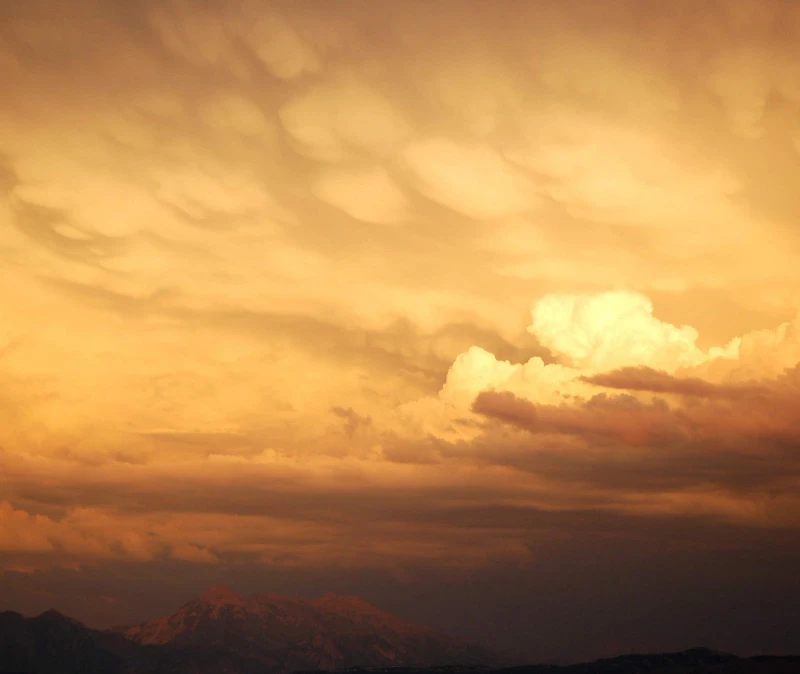Have you ever looked up at the sky and noticed that it had turned yellow? A yellow sky may seem unusual, but it can hold significant meaning and symbolism. In this article with Impeccable Nest, we will explore the yellow sky meaning, what does a yellow sky mean, and whether it is bad if the sky is yellow.

What Does a Yellow Sky Mean?
A yellow sky can have various meanings depending on the context and culture. Here are some of the most common interpretations:
1. Impending Storm or Natural Disaster
A yellow sky can have different meanings depending on the context and circumstances in which it appears. In some cases, a yellow sky may indicate an incoming storm or natural disaster such as a hurricane, tornado, or wildfire. This is because the yellow hue is caused by the scattering of sunlight through the atmosphere, which occurs when there is a high concentration of dust, pollution or smoke in the air.
When sunlight enters the Earth’s atmosphere, it is scattered in all directions by air molecules, which causes the blue color of the sky. However, when there are other particles in the air, such as dust, smoke or pollution, this scattering effect is altered, resulting in a yellowish or orange hue.
If you notice a yellow sky in your area, it is crucial to stay informed of weather updates and take necessary precautions. Depending on the severity of the situation, authorities may issue evacuation orders or emergency alerts to ensure the safety of residents.
In areas where storms are common, having a plan in place for severe weather events is critical. This may include having an emergency kit with essential supplies such as food, water, medications, and first aid supplies. It is also advisable to have a communication plan with family members or friends who may be affected by the same event.
2. Air Pollution
Yellow sky is a phenomenon that can result from various natural and artificial factors. In some cases, it may signify the presence of air pollution caused by human activities. When pollutants like nitrogen oxides and sulfur dioxide, which are often produced by vehicles, factories, or power plants, mix with sunlight, they create a yellow haze that covers the sky.
This situation is particularly common in heavily industrialized areas, where the concentration of pollutants is higher. The yellow color of the sky indicates that the air quality is poor, and the level of particulate matter is elevated. This can pose a risk to individuals with respiratory problems, as exposure to polluted air can aggravate existing conditions such as asthma or bronchitis.
Apart from being harmful to human health, air pollution can also have negative effects on the environment. For example, it can contribute to global warming, acid rain, and the depletion of the ozone layer. Therefore, it is essential to take measures to reduce emissions and control the amount of pollution released into the atmosphere.
3. Symbolism
In various cultures and belief systems, the color yellow is often associated with positive attributes such as warmth, happiness, and energy. When it comes to the sky taking on a yellow hue, the meaning can vary depending on the beliefs of the people who are observing it.
For instance, in Chinese mythology, the earth element is traditionally represented by the color yellow. Therefore, when the sky appears yellow, it may be interpreted as a symbol of stability, grounding, and nourishment. This is because the earth is seen as the foundation for life, and having a stable foundation is necessary for growth and prosperity.
In Hinduism, the yellow color is associated with the solar plexus chakra, which is believed to be located in the upper abdomen and is linked to personal power and self-esteem. When the sky takes on a yellow hue, it may be interpreted as a sign that the individual should focus on building their confidence and taking control of their life. The color yellow is also associated with the sun, and the solar plexus chakra is believed to be closely linked to this celestial body.
Causes of a Yellow Sky
A yellow sky can be caused by a variety of natural and man-made factors. Here are some of the possible causes:
- Air pollution: One of the most common causes of a yellow sky is air pollution. When the air is filled with pollutants such as dust, smoke, and other particles, it can create a hazy or yellowish hue in the sky. This is especially true in urban areas with high levels of vehicle traffic and industrial activity.
- Wildfires: Another cause of a yellow sky is wildfires. When large fires burn, they release smoke and ash into the air, which can create a yellow or orange tint to the sky. This effect can often be seen for miles around the fire location.
- Volcanic eruptions: Volcanic eruptions can also cause a yellow sky. When a volcano erupts, it releases sulfur dioxide gas, which can react with water vapor in the atmosphere to create sulfuric acid clouds. These clouds can reflect sunlight and create a yellow or orange tint to the sky.
- Sandstorms: In desert regions, sandstorms can occur and cause a yellow sky. As strong winds pick up sand and dust particles from the ground, they can create a thick cloud that covers the sky. This cloud can sometimes create a yellow or orange tint to the sky.
- Weather conditions: Certain weather conditions can also cause a yellow sky. For example, during a sunset or sunrise, the angle of the sun can create a golden or yellow glow in the sky. Additionally, certain cloud formations, such as altocumulus clouds, can create a yellowish hue in the sky.
In conclusion, a yellow sky can be caused by various natural and man-made factors, including air pollution, wildfires, volcanic eruptions, sandstorms, and certain weather conditions. While a yellow sky may create a unique and beautiful sight, it is important to consider the underlying causes and take steps to mitigate any negative impacts on the environment and public health.
Is It Bad if the Sky is Yellow?
If the sky turns yellow, it may be an indication of a severe weather condition or atmospheric pollution, which can have harmful effects on human health and the environment. The color of the sky is determined by the amount and type of particles in the atmosphere, as well as the angle at which sunlight passes through it.
A yellow sky can be caused by several factors such as wildfires, dust storms, volcanic eruptions, and air pollution. Wildfires and dust storms can release large amounts of smoke and dust into the air, which can reflect and scatter sunlight, leading to a yellowish hue in the sky. Similarly, volcanic eruptions can spew ash and sulfur dioxide into the atmosphere, causing the sky to appear yellow or even green.
Air pollution, particularly from industrial activities and vehicular emissions, can also cause the sky to turn yellow. This is because pollutants such as nitrogen oxides and sulfur dioxide can react with sunlight to create a yellowish haze called smog. Breathing in smog can irritate the lungs and aggravate respiratory conditions such as asthma.
Moreover, yellow skies can have adverse effects on agriculture and the economy. For instance, prolonged exposure to smog can damage crops and reduce crop yields, resulting in food shortages and higher prices. It can also impact tourism, as visitors may avoid areas with poor air quality and yellow skies.
In conclusion, a yellow sky can potentially indicate severe weather conditions or atmospheric pollution, which can have negative impacts on human health, the environment, agriculture, and the economy. Therefore, it is crucial to monitor and address the causes of a yellow sky promptly to minimize the harm it can cause.
Conclusion
A yellow sky can hold various meanings depending on the context and culture. Whether it is bad for your health or not depends on the cause. If you notice a yellow sky, it is essential to understand the underlying meaning and take necessary precautions. Stay safe and informed about weather updates, air quality, and health risks associated with pollution.

Hey there! I am Salena Snyde, a dream psychologist with over 10 years of experience. I am the primary author of the Dream Meanings section on Impeccable Nest, where I not only share in-depth knowledge about the nature, function, and significance of dreams but also connect with readers through profound articles and quality information. With passion and a diverse knowledge of dreams, I have established strong connections with dream experts worldwide by reading articles and studying leading books on the subject. I believe that the combination of personal insights and sharing from the dream expert community can provide the most profound and comprehensive understanding for everyone.
